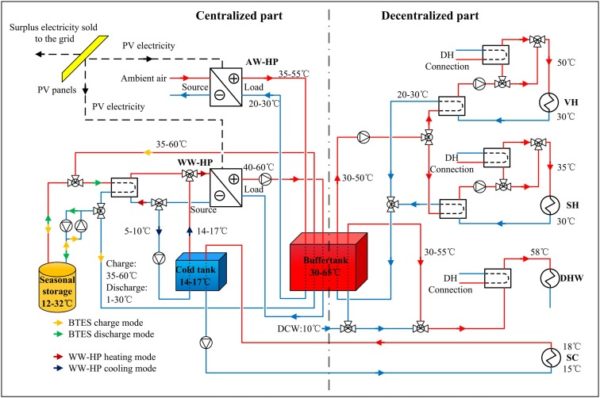An international group of researchers has proposed the use of borehole thermal energy storage (BTES) to store PV electricity during warmer parts of the year in residential districts. It has designed a low-temperature hybrid energy system that can purportedly cover between 38% and 58% of district heating demand.
The proposed system configuration is applicable to locations with a high seasonal mismatches between solar radiation and heating demand. It was simulated with TRNSYS software, which is used to simulate the behavior of transient renewables systems. It was modeled via Simulink (MATLAB), in order to read the simulation results and complete the life-cycle calculation.
The system is based on the use of PV systems, air-to-water heat pumps (AW-HPs), water-to-water heat pumps (WW-HPs), a buffer tank for short-time heat storage, and BTES for seasonal heat storage. Additional heat energy may be imported from the district heating network, when needed, as the system is not fully self-sufficient.
It uses PV electricity to power the AW-HPs and provide heat to the buffer tank.
“Once the temperature in the tank reaches the upper limit, the heat energy is discharged from the buffer tank to the BTES,” the scientists explained, noting that the discharge mode operates in the winter. “Finally, WW-HPs, connecting the BTES and buffer tank, operate during the discharge period to heat the water in the buffer tank so that the required temperature of the building heating network can be met.”
The buffer tank begins discharging the heat to the BTES for seasonal storage when the temperature is above 45 C and stops when the tank temperature drops to 30 C.
“As the system is only designed to cover some share of annual total heating demand, it is more reasonable to utilize the on-site heat energy during the high heating demand period,” the research group emphasized. “Thus, the BTES only discharges heat energy when the sum of SH and VH demand exceeds 30 kW and the outdoor air temperature is below 5 C.”
Popular content

Image: Aalto University, Energy Conversion and Management, Creative Commons License CC BY 4.0
For their case, the scientists selected a residential neighborhood in Espoo, Finland. The area features 14 eight-floor residential buildings and has a total floor area of 31,100 square meters. They assumed that PV systems in the district would have a total capacity of 340 kW covering half of the available rooftop surface of around 4100 square meters. AW-HPs and WW-HPs were assumed to have capacities of 20 kW and 60 kW, respectively.
“Both AW-HPs and WW-HPs can operate in part-load conditions with a minimum part-load ratio of 10%,” the scientists said. “Both AW-HPs and WW-HPs can operate in part-load conditions with a minimum part-load ratio of 10%.”
According to the researchers, this system configuration is able to produce heat energy, without using grid electricity, with a leveleized cost of energy (LCOE) ranging from €110 ($114.9) to €184/MWh. When grid power is used, they found the LCOE may range between €108 and €201/MWh.
“As the on-site energy is produced based on PV electricity generation, the available rooftop area becomes the main limit for improvement of the system performance,” they said. “If larger PV power stations (on external structures or vertically on the walls) can be utilized to produce heat energy, Renewable Energy Fraction (REF) can be higher and the system might be more feasible.”
The academics presented the hybrid system in “System modelling and optimization of a low temperature local hybrid energy system based on solar energy for a residential district,” which was recently published in Energy Conversion and Management. The research team includes scientists from the Aalto University in Finland and Tongji University in China.
“Although the initial cost of the studied system is higher than that of district heating, the local hybrid energy system is worth further developing considering decentralizing heat energy production and reducing CO2 emissions,” they said.
This content is protected by copyright and may not be reused. If you want to cooperate with us and would like to reuse some of our content, please contact: editors@pv-magazine.com.



Tanks to God and Thanks to Sun for solar energy
I am very interested like this projects and inventors